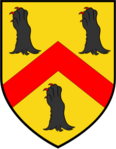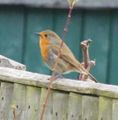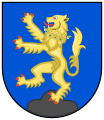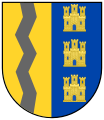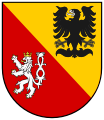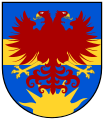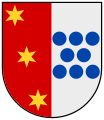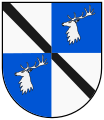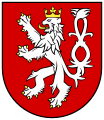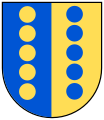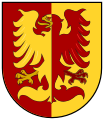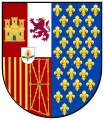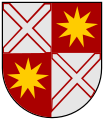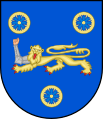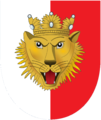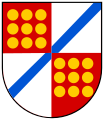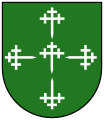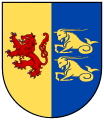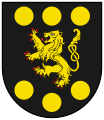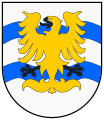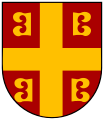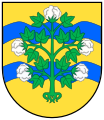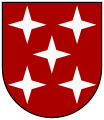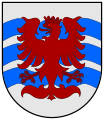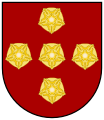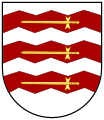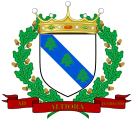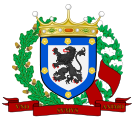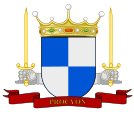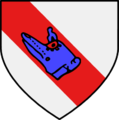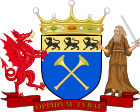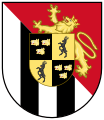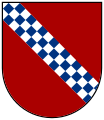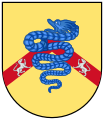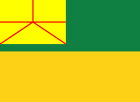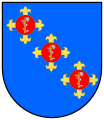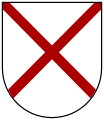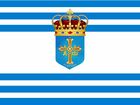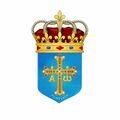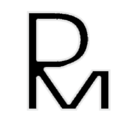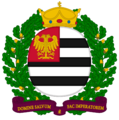National symbols of Austenasia
This article lists notable national symbols of the Empire of Austenasia.
Flag
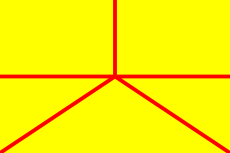 |
|
| Use | National flag and ensign |
|---|---|
| Proportion | ~7:11 (427:640) |
| Adopted | 8 November 2008 |
| Design | A "yellow background with five red lines on it... [going] from the centre of the flag, one to the centre of the top side of the flag, one to the centre of the left side of the flag, one to the centre of the right side of the flag, one to the bottom-left corner and one to the bottom-right corner". |
| Designed by | Crown Prince Jonathan[1] |
The national flag of the Empire of Austenasia, known as the Austenasian Star,[2] is the flag used to represent the country and its people. The current flag was designed by Emperor Jonathan I while still Crown Prince.
The design is loosely based on a combination of the St. George's Cross and the coat of arms of the House of Austen, both of which can be seen below:
-
The St. George's Cross, the flag of England.
-
The arms of the House of Austen.
An Austenasian Star flies from the Imperial Residence for much of the year, only usually being taken down during strong winds, heavy rain, or high temperatures (due to there being no flagpole, the flag is hung from the windows of the Imperial Quarters, meaning that they cannot be opened when the flag is flying). The flag always flies on public holidays, as well as on birthdays of members of the Imperial Family and of fellow Emperors. During times of mourning, as well as on Remembrance Day, the flag is flown vertically instead of horizontally, a gesture which has become the alternative to having it flown half-mast (there being no flag pole).
Coat of arms
| Coat of Arms of the Empire of Austenasia | |
|---|---|
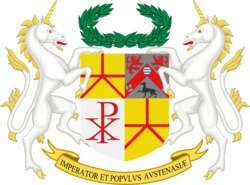 | |
| Details | |
| Armiger | The Emperor of Austenasia |
| Adopted | 15 July 2011 |
| Crest | Laurel wreath |
| Escutcheon | Quaterly: 1st and 4th the Austenasian Star proper; 2nd Eisenfarbe a chevron Gules charged with two Acorns of the first per chevron on each side of a fountain between two lioncels combatant of the same and in base a greyhound passant Sable (Carshalton); 3rd argent a Chi-Rho gules. |
| Supporters | Unchained unicorns argent |
| Motto | Latin: IMPERATOR ET POPVLVS AVSTENASIAE |
The coat of arms of Austenasia was created on 15 July 2011 by Act 153 (Coat of Arms and other National Symbols) - prior to this, the Empire had not had an official coat of arms.
The shield in the centre of the coat of arms is quartered, in the same design as the Imperial Standard. The first and fourth quadrants represent the Empire and are comprised of the Austenasian Star, the Empire's national flag; the second quadrant represents the British town of Carshalton, from which the Empire declared independence in 2008, and is comprised of the arms of said town; and the third quadrant is comprised of a Chi-Rho, a Christian symbol used in late Western Roman imperial insignia, representing both the Christian heritage of Austenasia and the claim to imperial rank of its Monarchs. The crest of the shield, a laurel wreath, also represents the imperial nature of the Austenasian Throne, being a wreath awarded to Roman imperators and the stereotypical headwear of the early emperors.
The shield has as its supporters two unchained unicorns, "to represent strength and freedom", symbols of the Empire's independence. The motto beneath the shield, IMPERATOR ET POPVLVS AVSTENASIAE ("the Emperor and People of Austenasia"), is based on the Roman emblem "SPQR".
National animals
The bullmastiff is the national animal of Austenasia, named as such on 7 March 2009 in honour of the immediate Imperial Family's pet dogs Rose and Edd (now deceased). Following in the examples of several U.S. states, other animals were also designated Austenasian symbols - the red deer is the Empire's national wild animal, the common frog its national amphibian, the British subspecies of the European robin its national bird, and the Spinosaurus its national dinosaur.
-
Bullmastiff
-
Red deer
-
Common frog
-
British Robin
-
Spinosaurus
National anthem
The national anthem of Austenasia is God Save the Emperor, written by the now Emperor Jonathan I while still Crown Prince, and based on and to the tune of God Save the King. The first verse of the anthem was adopted on 4 April 2009 by Act 71 (National Anthem). The other two verses were added on 29 March 2011 by Act 147 (Addition to National Anthem), with an amendment to the third verse being made on 20 September 2013 by the Seventh Imperial Edict of Jonathan I.
Should there be a female Monarch, all instances of the word "Emperor" in the anthem will be replaced with "Empress". Between 19 December 2010 and 20 September 2011, Esmond III and Declan I reigned together as joint Monarchs - during this time, the anthem was known as "God Save the Emperors", and all references to the Monarch were in the plural.
The national anthem as currently sung is as follows:
God save the Emperor,
long live the Emperor,
long may he reign!
Send him victorious,
happy and glorious,
long to reign over us:
Austenasia!
Our lovèd Monarch bless
with peace and happiness
for evermore;
and let the Empire be
united, loyal, free;
this home of you and me,
Austenasia!
This, our great glorious land,
lives by the Monarch's hand,
all hail his Throne!
Long will the Empire reign,
glory and wealth to gain,
sing that great name again;
Austenasia!
Sub-national flags, arms and emblems
Regions
-
Arms of Britannia
-
Arms of Northern Austenasia
-
Arms of Germania
-
Arms of Asia Minor
-
Arms of Gallia
-
Arms of Sarmatia
Duchies
-
Arms of Royton
-
Arms of Davidopia
-
Arms of Grantabridge
-
Arms of New Royton
-
Arms of Bohemia
-
Arms of Occidentia
-
Arms of Opsikion
-
Arms of Taysha
-
Arms of Dixie
-
Arms of Aesti
Provinces
-
Arms of Greater Wrythe
-
Arms of Nearloch
-
Arms of Greater Corinium
-
Arms of Vienna
-
Arms of Colltiree
-
Arms of Linnheside
-
Arms of Greater Hoagland
-
Arms of Rokytka
-
Arms of Bithynia
-
Arms of Oribrazos
-
Arms of Cowyetton
-
Arms of Maritimae
-
Arms of Occibrazos
-
Arms of Julian
Cities
-
Arms of Wrythe
Towns
-
Flag of Palasia
-
Flag of Nahona
-
Arms of Nahona
-
Flag of North Nahona
-
Arms of North Nahona
-
Flag of Procyon
-
Arms of Procyon
-
Flag of Blue Ridge
-
Arms of Blue Ridge
-
Arms of Oppidum Tubae
-
Arms of Helinium
-
Flag of Chandler
Marches
-
Flag of Caldari
-
Arms of Caldari
-
Flag of Campo de Jonatán
-
Arms of Campo de Jonatán
Territories
-
Arms of Cenomannica
-
Flag of Corinium Terentium
-
Arms of Corinium Terentium
-
Flag of Green Gate
-
Flag of Oberfalcer
-
Flag of Peach Ponds
-
Arms of Nikaia
-
Flag of Florencium Carolina
-
Arms of Florencium Carolina
-
Flag of Jackson
-
Arms of Jackson
-
Flag of Western Jarrahview
-
Flag of Rubrum Beryllium
-
Flag of Nervenston
-
Flag of Prahova
-
Flag of Elmythia
-
Arms of Elmythia
-
Flag of Glainamar
-
Arms of Glainamar
-
Arms of Garelsh
Crown Dependencies
-
Flag of New South Scotland
-
Flag of Enfriqua
-
Arms of Enfriqua
-
Flag of Dekker
-
Flag of Esmondia
-
Flag of Rushymia
-
Flag of Kingeston
-
Flag of Trebizond
-
Arms of Trebizond
-
Flag of Chersoneses
-
Flag of Kaiomenia
-
Flag of New Pontunia
-
Arms of New Pontunia
-
Flag of Navurania

